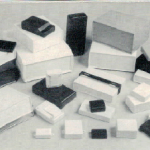 Plastic, where would we be without it? It has become so much a part of our everyday lives that it’s similar to how we react when our electricity goes out – we keep hitting the switch waiting for the lights to come on. If you think you could live a day without plastic, take a good look around and think about how many things that are made of plastic are a part of our everyday life.
Plastic, where would we be without it? It has become so much a part of our everyday lives that it’s similar to how we react when our electricity goes out – we keep hitting the switch waiting for the lights to come on. If you think you could live a day without plastic, take a good look around and think about how many things that are made of plastic are a part of our everyday life.
We get up in the morning, make our coffee from a coffeemaker that is shaped out of plastic, brush our teeth with a plastic toothbrush and take a swig of orange juice from a plastic container – and we haven’t even left the house yet.
So how did this substance come to be? Well it started in the 1860s with a contest by a billiards company that was looking for someone to create a substitution for the natural ivory they used in the balls for their pool tables. John Wesley Hyatt, a young inventor, mixed pyroxylin, which was a combination of nitric acid and cotton, with camphor and came up with a substance that his brother called Celluloid. He didn’t win the contest but he did make history with the creation of the first plastic made in America.
While Celluloid didn’t work for the billiard company it did work for George Eastman, a pioneer in photography. The Celluloid was able to be easily shaped and even flattened out into strips. Eastman used Celluloid as film for the very first movie produced in 1882.
The next major breakthrough in the field of plastic came in the early 1900s. A Belgian/American chemist by the name of Leo Hendrik Baekland created what is considered the first synthetic plastic. The substance, called Bakelite, made great strides in the evolution of plastic because when it was liquefied it was able to be shaped and keep its form, a process that is still used today.
By the 1920s polyvinyl chloride (PVC) and Nylon were introduced. By the 1930s polystyrene was one of the biggest selling plastics on the market. It had a major impact on our lives in the form of toys, housewares and even played a part in the packaging industry.
The next big thing, polyethylene, was used during World War II for radar cable and has evolved into the plastic that we use the most to this day. Thermoset polyester resins were also created and used for the military but later became a vital part in building boats in the US. And then came acrylonitrile-butadiene-styrene plastics, luckily shortened down to ABS, which has many applications in our lives today. ABS is used in luggage, safety helmets and the housings of our major appliances among other things.
On to the 50s and DuPont markets a fabric made of polyester called Dacron. In 1953 Lexan was created by a researcher for General Electric and when Buzz Aldrin and Neil Armstrong walked on the moon they were wearing pressure helmets that had been made from Lexan.
In 1965 a scientist from DuPont worked her magic by spinning fibers from liquid crystalline materials which resulted in Kevlar the material that bulletproof vests are made from.
The development of plastics continues today. Because some of the products that we currently use are not biodegradable, plastics often get a bad rap. But unlike any other products that we use today it would be nearly impossible to get through the day without plastics.


![The History of Plastic [INFOGRAPHIC]](https://www.simcobox.com/blog/wp-content/uploads/2014/03/History-of-Plastic-za-bloga2-150x150.jpg)



